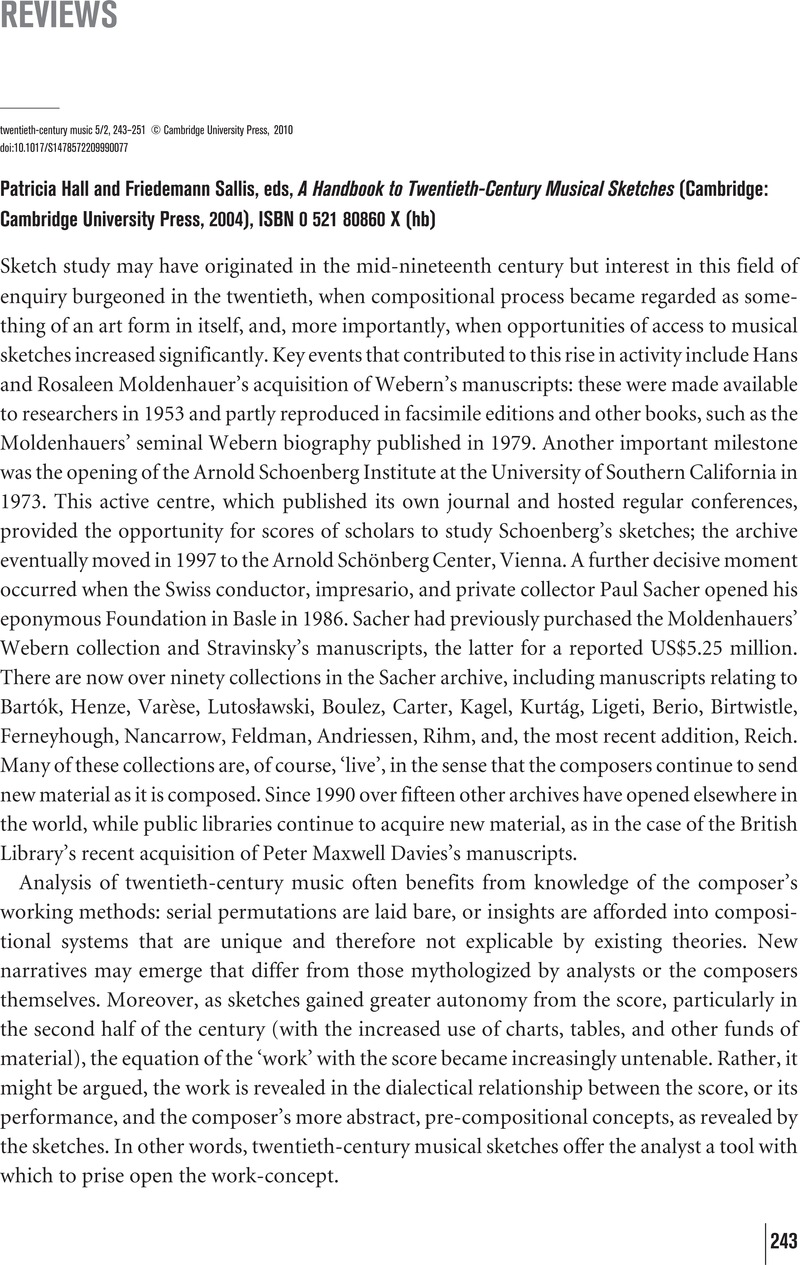No CrossRef data available.
Article contents
Patricia Hall and Friedemann Sallis, eds, A Handbook to Twentieth-Century Musical Sketches (Cambridge: Cambridge University Press, 2004), ISBN 0 521 80860 X (hb)
Published online by Cambridge University Press: 05 February 2010
Abstract

- Type
- Reviews
- Information
- Copyright
- Copyright © Cambridge University Press 2010
References
1 See Douglas Johnson, ‘Beethoven Scholars and Beethoven's Sketches’, 19th-Century Music 2/1 (1978–9), 3–17, and responses in the same volume, 270–79.
2 See Dai Griffiths, Review of A. C. Schreffler, Webern and the Lyric Impulse: Songs and Fragments on Poems of Georg Trakl (1994), Music Analysis 16/1 (1997), 144–54.
3 For an excellent summary of sketch study issues, together with an outline of Kerman's broader vision for their use see Joseph Kerman, ‘Viewpoint: Sketch Studies’, 19th-Century Music 6/2 (1982), 174–80.
4 Alain Frogley, Vaughan Williams's Ninth Symphony (Oxford: Oxford University Press, 2002), 2. However, Frogley resists hermeneutic endeavour for the most part until the final chapter of his book.
5 For example, a recent symposium hosted by IRCAM entitled ‘The Politics of Music Analysis’ (27–8 April 2007) was advertised as bringing together researchers to consider ‘a question that is the subject of hot debates in American universities and that is hardly discussed in France’ (IRCAM Newsletter received by the author on 22 March 2007).
6 For example, Ethan Haimo has questioned the basis for Allen Forte's application of set-class theory when analysing Schoenberg's atonal music; Forte claims that Schoenberg was working with unordered pitch-class sets at this stage (even suggesting that he had favourite hexachordal pairs of sets), yet Haimo finds no such evidence in the sketches or writings from that period. Moreover, the sketches for the earliest serial works clearly indicate that Schoenberg's technique evolved from tentative, sometimes clumsy attempts, in which some of the most basic transpositional procedures were written down, suggesting that he was beginning to think in such terms for the first time. See Ethan Haimo, ‘Atonality, Analysis, and the Intentional Fallacy’, Music Theory Spectrum 18/2 (1996), 167–99.
7 Joseph Auner, Kathryn Bailey, Catherine Dale, Ethan Haimo, Gretchen Horlacher, Lynne Rogers, Roger Smalley, David Smyth, Susannah Tucker and Stephen Walsh are just some of a long list of people who have worked on Stravinsky or Schoenberg sketches but whose work is not referenced in the bibliography.
8 See Griffiths, Review of Schreffler.
9 Elliott Carter, in Jonathan Bernard, ‘An Interview with Elliott Carter’, Perspectives of New Music 28/2 (1990), 205.
10 This was edited and published by Nicholas Hopkins and John F. Link in 2002; Elliott Carter, Harmony Book (New York: Carl Fischer, 2002).
11 See, for example, Martin Scherzinger, ‘Remarks on a Sketch of György Ligeti: a Case of African Pianism’, Mitteilungen der Paul Sacher Stiftung 20 (2007), 32–7.
12 See Richard Taruskin, ‘Russian Folk Melodies in The Rite of Spring’, Journal of the American Musicological Society 33/3 (1980), 501–43, especially 512. Taruskin drew directly on Lawrence Morton's sketch study, ‘Footnotes to Stravinsky Studies: Le Sacre du Printemps’, Tempo 128 (1979), 9–16, which presented the first evidence of Stravinsky's use of folk sources in The Rite. See also David J. Code, ‘The Synthesis of Rhythms: Form, Ideology and the Augurs of Spring’, Journal of Musicology 24/1 (2007), 112–66.




